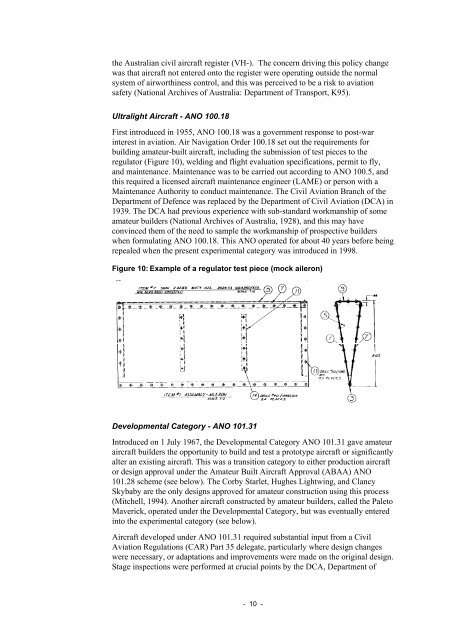Amateur-built and experimental aircraft - Australian Transport Safety ...
Amateur-built and experimental aircraft - Australian Transport Safety ...
Amateur-built and experimental aircraft - Australian Transport Safety ...
Create successful ePaper yourself
Turn your PDF publications into a flip-book with our unique Google optimized e-Paper software.
the <strong>Australian</strong> civil <strong>aircraft</strong> register (VH-). The concern driving this policy change<br />
was that <strong>aircraft</strong> not entered onto the register were operating outside the normal<br />
system of airworthiness control, <strong>and</strong> this was perceived to be a risk to aviation<br />
safety (National Archives of Australia: Department of <strong>Transport</strong>, K95).<br />
Ultralight Aircraft - ANO 100.18<br />
First introduced in 1955, ANO 100.18 was a government response to post-war<br />
interest in aviation. Air Navigation Order 100.18 set out the requirements for<br />
building amateur-<strong>built</strong> <strong>aircraft</strong>, including the submission of test pieces to the<br />
regulator (Figure 10), welding <strong>and</strong> flight evaluation specifications, permit to fly,<br />
<strong>and</strong> maintenance. Maintenance was to be carried out according to ANO 100.5, <strong>and</strong><br />
this required a licensed <strong>aircraft</strong> maintenance engineer (LAME) or person with a<br />
Maintenance Authority to conduct maintenance. The Civil Aviation Branch of the<br />
Department of Defence was replaced by the Department of Civil Aviation (DCA) in<br />
1939. The DCA had previous experience with sub-st<strong>and</strong>ard workmanship of some<br />
amateur builders (National Archives of Australia, 1928), <strong>and</strong> this may have<br />
convinced them of the need to sample the workmanship of prospective builders<br />
when formulating ANO 100.18. This ANO operated for about 40 years before being<br />
repealed when the present <strong>experimental</strong> category was introduced in 1998.<br />
Figure 10: Example of a regulator test piece (mock aileron)<br />
Developmental Category - ANO 101.31<br />
Introduced on 1 July 1967, the Developmental Category ANO 101.31 gave amateur<br />
<strong>aircraft</strong> builders the opportunity to build <strong>and</strong> test a prototype <strong>aircraft</strong> or significantly<br />
alter an existing <strong>aircraft</strong>. This was a transition category to either production <strong>aircraft</strong><br />
or design approval under the <strong>Amateur</strong> Built Aircraft Approval (ABAA) ANO<br />
101.28 scheme (see below). The Corby Starlet, Hughes Lightwing, <strong>and</strong> Clancy<br />
Skybaby are the only designs approved for amateur construction using this process<br />
(Mitchell, 1994). Another <strong>aircraft</strong> constructed by amateur builders, called the Paleto<br />
Maverick, operated under the Developmental Category, but was eventually entered<br />
into the <strong>experimental</strong> category (see below).<br />
Aircraft developed under ANO 101.31 required substantial input from a Civil<br />
Aviation Regulations (CAR) Part 35 delegate, particularly where design changes<br />
were necessary, or adaptations <strong>and</strong> improvements were made on the original design.<br />
Stage inspections were performed at crucial points by the DCA, Department of<br />
- 10 -

















